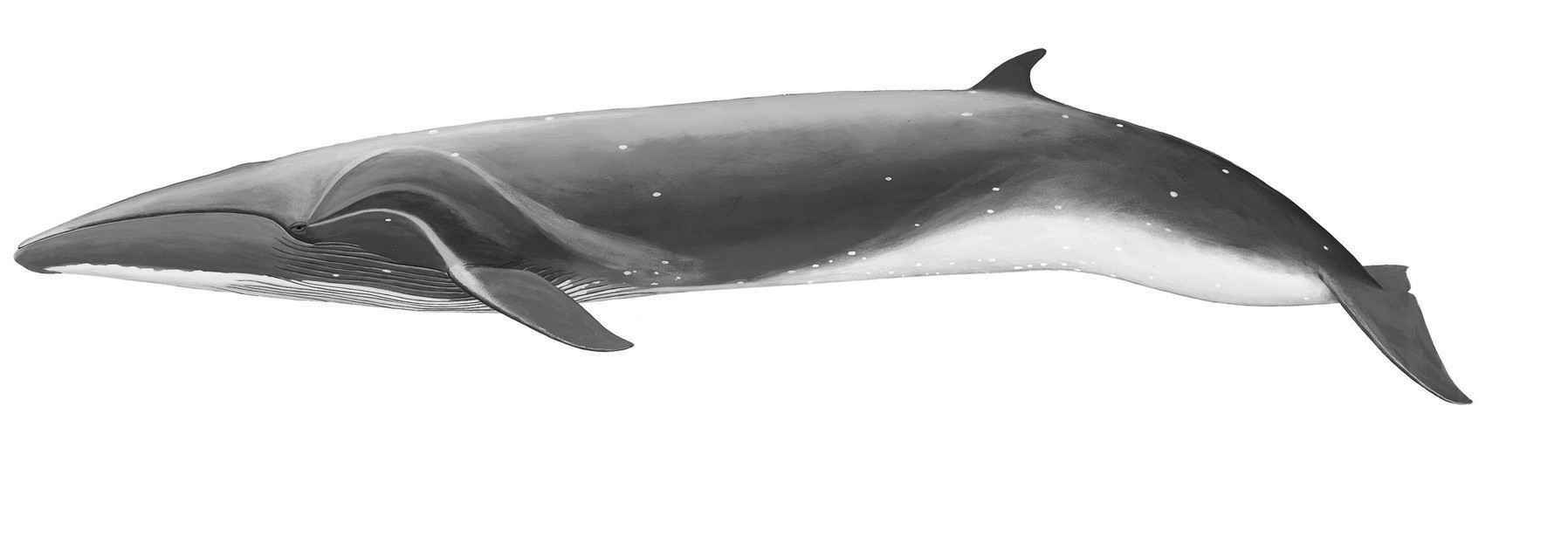SEI WHALE
Balaenoptera borealis Lesson 1828
Order Cetacea : Family Balaenopteridae
DESCRIPTION. A medium-sized baleen whale, typically reaching lengths of 15–16 m. Females are usually slightly larger than males of comparable age and may attain maximum lengths of 20 m. Average weight is 13–15 metric tons. Coloration is dark bluish gray with a white patch in the area of the ventral pleats. Flanks and belly are mottled with light gray to whitish marks. Dorsal fin is tall, up to 61 cm in height, strongly curved or hooked, and situated farther forward on the body than in blue or fin whales. These whales are similar in color and size to Bryde's whale, and the two are difficult to distinguish at a distance; close inspection of the head reveals that sei whales have a single head ridge, whereas Bryde's whales have three head ridges.

DISTRIBUTION. Although sei whales occur in all of the major oceans, they tend to remain in more temperate waters than do most rorquals. In the western North Atlantic, they are found mainly in offshore waters from the Gulf of Mexico and Caribbean Sea northward to Nova Scotia and Newfoundland. One stranding has been documented from the Gulf shores of Texas—a mummified skeleton found 31 km (19 mi.) from Freeport, Brazoria County, on 20 November 2002.
SUBSPECIES. Balaenoptera b. borealis.
HABITS. Like other baleen whales, sei whales are highly migratory. Calving and mating occur during the winter in tropical and subtropical waters. In spring and summer they move to high-latitude feeding grounds but rarely penetrate far into polar regions.
Sei whales are usually encountered in small groups of two to five animals but may be found in larger congregations in summer feeding grounds. Unlike most other balaenopterids, which feed by engulfing huge amounts of water at one time, sei whales often skim their food from the water surface. This behavior has been observed as the whales fed on plankton near the surface. They also feed on fishes, however, including anchovies, mackerel, cod, and others.
Adult females give birth to a single calf at 2–3 year intervals following a gestation period of 11–12 months. Newborns suckle for approximately 6 months and are sexually mature at 8 years.
POPULATION STATUS. Extralimital; rare; strandings. Only four reliable records are available from the Gulf of Mexico, and the sei whale is considered of accidental occurrence in the region. Strandings have been recorded from eastern Louisiana, from the Florida Panhandle, and one from the Texas coast.
CONSERVATION STATUS. The USFWS lists the sei whale as endangered, but it is not listed by TPWD. The IUCN listing is endangered because the global mature population is estimated to have declined by about 80% over the last three generations. This estimate is supported by observed declines in abundance in several regions, with much of the decline in the southern hemisphere.
From The Mammals of Texas, Seventh Edition by David J. Schmidly and Robert D. Bradley, copyright © 1994, 2004, 2016. Courtesy of the University of Texas Press.
Natural Science Research Laboratory
-
Address
Museum of Texas Tech University, 3301 4th street, Lubbock, TX 79409 -
Phone
806.742.2486 -
Email
nsrl.museum@ttu.edu

